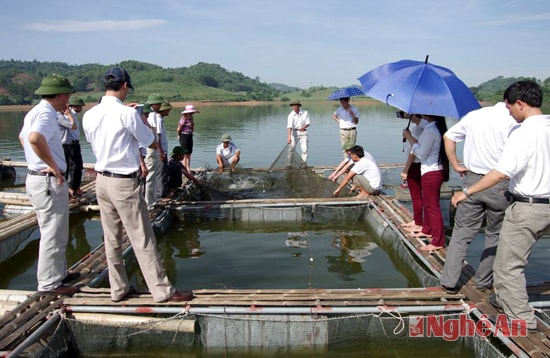Effectiveness of raising catfish in cages
(Baonghean) - Catfish is known as one of the fish species with high economic value, often found in rivers and streams in the northern provinces, especially in the middle and upper regions, where there are fast flowing water. Currently, Catfish is at risk of depletion in the wild, so it is considered a rare aquatic specialty.
 |
| Visit the catfish farming model on Khe Da lake. |
Grasping the increasing demand of people for this type of fish with high economic value, Mr. Ngo Sy Hiep - Project Manager: "Application of science and technology to build a model of commercial catfish farming in cages on large water bodies in Nghe An" has boldly deployed a model of commercial catfish farming in Khe Da Lake, Nghia Dan. Surveying the natural conditions here, it is very suitable for cage catfish farming. The lake has a total open surface area of 500 hectares, with a water capacity of over 13 million m3, natural factors ensure the growth and development of freshwater fish species in general and catfish in particular. In particular, the lake has a large reserve of trash fish of 35 - 40 tons/year, exploited all year round. This is a very good source of fresh food for catfish, ensuring the growth and development of fish, limiting diseases.
With support from scientific funding, he invested in 10 cages with a volume of 100m3, the fry were imported from the Aquaculture Research Institute I, with 3,000 fish released. After nearly 20 months of implementing the model, Mr. Hiep said: "Raising catfish is not too difficult, because it only needs to be raised in places where the water flows regularly, is not polluted, the cage system is designed appropriately; ensuring that during the raising process, the fish are cared for, and diseases are prevented and treated promptly. Fish food should be put in a sieve to avoid the phenomenon of fish falling out of the side of the cage before they have time to eat; regularly clean the trash and silt that sticks to the cage. The main food source is trash fish exploited directly from Khe Da Lake, so it is quite convenient"
Mr. Hiep also said that the catfish has slightly yellow meat, lean, chewy, crispy, has a characteristic flavor and high nutritional value, so the output is quite easy. The price of commercial fish depends on the time, size and method of harvesting and preserving the product after harvesting. Live fish weighing less than 1kg/fish costs 150,000 VND/kg, those weighing more than 1kg/fish cost 230,000 VND/kg. When there is a large quantity of fish, traders will directly come to purchase and transport live fish to the northern provinces for consumption, with each trip catching from 150 - 200 kg. The net profit is 96,710,000 VND, an average profit of over 4,800,000 VND/month. Compared to investing in raising traditional fish such as grass carp, tilapia... it is clear that raising commercial catfish in cages is more economically efficient.
Although the cage fish farming model on Khe Da Lake, Nghia Dan has brought practical results and has been supported by all levels and sectors, there is still a concern that the source of fish fry is still dependent. Therefore, to help people have the conditions to be proactive and expand the scale of cage fish farming, the Fisheries sector needs to research technical measures for artificial reproduction of fish fry, thereby proactively taking the initiative in the source of local fry. It can be said that raising fish fry is not only preserving rare aquatic breeds, but also an opportunity to maintain, replicate, and develop new aquaculture models, with high economic efficiency, opening up directions for economic development, helping local people to escape poverty and get rich. Hopefully, when proactive in the source of fry, the project will expand the model so that many households in the province have the conditions to raise and expand the area on lakes, rivers and streams.
Article and photos:Thanh Hoa






